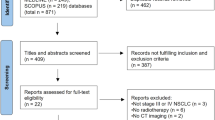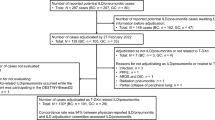Abstract
Purpose:
To analyze the association of patient- and treatment-related factors with the onset of radiation pneumonitis in a homogeneously treated cohort of patients suffering from small cell lung cancer (SCLC).
Patients and Methods:
242 patients with SCLC staged as limited disease, who had been treated with chemotherapy and three-dimensional conformal radiotherapy, were retrospectively analyzed. Pneumonitis was defined by typical symptoms and radiographic findings and judged clinically relevant, if drug administration and hospitalization were necessary. Patient- (age, gender, smoking history, performance status, tumor localization, benign lung disease) and treatment-related parameters (V10–V40, mean lung dose [MLD]) were analyzed using χ2-tests for categorical parameters and logistic regression for continuous variables.
Results:
33 patients (13.6%) developed a clinically relevant pneumonitis, of whom three patients died. All cases of pneumonitis developed within 120 days. None of the patient-related parameters correlated significantly with the onset of pneumonitis. Considering treatment-related parameters, a significant correlation of V30 in regard to total lung and V40 in regard to ipsilateral, contralateral and total lung to the risk of pneumonitis was found. So, the estimated risk of a clinically relevant pneumonitis increased from 10% given a V30 of 13% to 30% given a V30 of 35%. In contrast, no significant correlation was found for V10 and V20 and only a trend for MLD.
Conclusion:
In this series, high-dose radiation volume parameters, i.e., V30 and especially V40, were identified as the most important factors for the development of radiation pneumonitis. Low-dose radiation volume parameters and clinical parameters played an inferior role in predicting the pneumonitis risk.
Zusammenfassung
Ziel:
Überprüfung der Assoziation von patienten- und therapiebezogenen Faktoren mit dem Auftreten einer radiogenen Pneumonitis in einem homogen behandelten Patientenkollektiv mit kleinzelligem Bronchialkarzinom (SCLC).
Patienten und Methodik:
242 Patienten mit SCLC im Stadium „limited disease“, welche mittels Chemotherapie und dreidimensionaler konformaler Radiotherapie behandelt waren, wurden retrospektiv analysiert. Pneumonitis wurde durch das Auftreten typischer Symptome und radiologischer Befunde definiert und als klinisch relevant eingestuft, wenn medikamentöse Behandlung und Klinikeinweisung nötig waren. Patienten- (Alter, Geschlecht, Rauchanamnese, Allgemeinzustand, Tumorlokalisation, gutartige Lungenerkrankung) und behandlungsbezogene Parameter (V10–V40, mittlere Lungendosis [MLD]) wurden mittels χ2-Tests für kategoriale Parameter und logistischer Regression für kontinuierliche Parameter analysiert.
Ergebnisse:
33 Patienten (13,6%) entwickelten eine klinisch relevante Pneumonitis, drei Patienten starben. Alle Pneumonitisfälle traten innerhalb von 120 Tagen auf. Für keinen der patientenbezogenen Parameter fand sich eine signifikante Korrelation mit dem Auftreten einer Pneumonitis. Hinsichtlich der behandlungsbezogenen Parameter zeigte sich eine signifikante Korrelation der V30 (gesamte Lunge) sowie der V40 (ipsilaterale, kontralaterale oder gesamte Lunge) mit dem Pneumonitisrisiko. So erhöhte sich das geschätzte Risiko einer klinisch relevanten Pneumonitis von 10% bei einer V30 von 13% auf 30% bei einer V30 von 35%. Im Gegensatz hierzu fanden sich keine signifikanten Korrelationen für V10 und V20 und nur ein Trend für die MLD.
Schlussfolgerung:
Hochdosis-Volumen-Parameter, d.h. V30 und besonders V40, konnten in dieser Serie als wichtigste Faktoren bezüglich der Entwicklung einer radiogenen Pneumonitis identifiziert werden. Niedrigdosis-Volumen-Parameter und klinische Parameter spielten eine untergeordnete Rolle bei der Vorhersage des Pneumonitisrisikos.
Similar content being viewed by others
References
Armstrong JG, Zelefsky MJ, Leibel SA, et al. Strategy for dose escalation using 3-dimensional conformal radiation therapy for lung cancer. Ann Oncol 1995;6:693–7.
Bischof M, Debus J, Herfarth K, et al. Surgery and chemotherapy for small cell lung cancer in stages I–II with or without radiotherapy. Strahlenther Onkol 2007;183:679–84.
Bölling T, Dirksen U, Ranft A, et al. Radiation toxicity following busulfan/melphalan high-dose chemotherapy in the EURO-EWING-99-trial: review of the GPOH data. Strahlenther Onkol 2009;185:Suppl 2:21–2.
Bölling T, Könemann S, Ernst I, et al. Late effects of thoracic irradiation in children. Strahlenther Onkol 2008;184:289–95.
Bölling T, Schuck A, Paulussen M, et al. Whole lung irradiation in patients with exclusively pulmonary metastases of ewing tumors. Toxicity analysis and treatment results of the EICESS-92 trial. Strahlenther Onkol 2008;184:193–7.
Byhardt RW, Scott C, Sause WT, et al. Response, toxicity, failure patterns, and survival in five Radiation Therapy Oncology Group (RTOG) trials of sequential and/or concurrent chemotherapy and radiotherapy for locally advanced non-small cell carcinoma of the lung. Int J Radiat Oncol Biol Phys 1998;42:469–78.
Claude L, Perol D, Ginestet C, et al. A prospective study on radiation pneumonitis following conformal radiation therapy in non-small-cell lung cancer: clinical and dosimetric factors analysis. Radiother Oncol 2004;71:175–81.
Gopal R, Tucker SL, Komaki R, et al. The relationship between local dose and loss of function for irradiated lung. Int J Radiat Oncol Biol Phys 2003;56:106–13.
Graham MV, Purdy JA, Emami B, et al. Clinical dose-volume histogram analysis for pneumonitis after 3D treatment for non-small cell lung cancer (NSCLC). Int J Radiat Oncol Biol Phys 1999;45:323–9.
Hernando ML, Marks LB, Bentel GC, et al. Radiation-induced pulmonary toxicity: a dose-volume histogram analysis in 201 patients with lung cancer. Int J Radiat Oncol Biol Phys 2001;51:650–9.
Hope AJ, Lindsay PE, El Naqa I, et al. Modeling radiation pneumonitis risk with clinical, dosimetric, and spatial parameters. Int J Radiat Oncol Biol Phys 2006;65:112–24.
Jeremic B, Shibamoto Y, Acimovic L, et al. Hyperfractionated radiation therapy with or without concurrent low-dose daily carboplatin/etoposide for stage III non-small cell lung cancer: a randomized study. J Clin Oncol 1996;14:1065–70.
Klautke G, Sauer R, Fietkau R. Combined treatment modality in small cell lung cancer. Strahlenther Onkol 2008;184:61–6.
Kong FM, Hayman JA, Griffith KA, et al. Final toxicity results of a radiation-dose escalation study in patients with non-small-cell lung cancer (NSCLC): predictors for radiation pneumonitis and fibrosis. Int J Radiat Oncol Biol Phys 2006;65:1075–86.
Mehta V. Radiation pneumonitis and pulmonary fibrosis in non-small-cell lung cancer: pulmonary function, prediction, and prevention. Int J Radiat Oncol Biol Phys 2005;63:5–24.
Mirri MA, Arcangeli G, Benassi M, et al. Hypofractionated conformal radiotherapy (HCRT) for primary and metastatic lung cancers with small dimension. Efficacy and toxicity. Strahlenther Onkol 2009;185:27–33.
Nieder C, Bremnes RM. Effects of smoking cessation on hypoxia and its potential impact on radiation treatment effects in lung cancer patients. Strahlenther Onkol 2008;184:605–9.
Oetzel D, Schraube P, Hensley F, et al. Estimation of pneumonitis risk in three-dimensional treatment planning using dose-volume histogram analysis. Int J Radiat Oncol Biol Phys 1995;33:455–60.
Peters N, Wieners G, Pech M, et al. CT-guided interstitial brachytherapy of primary and secondary lung malignancies. Results of a prospective phase II trial. Strahlenther Onkol 2008;184:296–301.
Rodrigues G, Lock M, D’souza D, et al. Prediction of radiation pneumonitis by dose-volume histogram parameters in lung cancer — a systematic review. Radiother Oncol 2004;71:127–38.
Schaake-Koning C, Bogaert W, Dalesio O, et al. Effects of concomitant cisplatin and radiotherapy on inoperable non-small cell lung cancer. N Engl J Med 1992;326:524–30.
Schild SE, Stella PJ, Geyer SM, et al. The outcome of combined-modality therapy for stage III non-small-cell lung cancer in the elderly. J Clin Oncol 2003;21:3201–6.
Schneider RA, Schultze J, Jensen JM, et al. 20 years of experience in static intensity-modulated total body irradiation and lung toxicity. Strahlenther Onkol 2007;183:545–51.
Schwarte S, Wagner K, Karstens JH, et al. Radiation recall pneumonitis induced by gemcitabine. Strahlenther Oncol 2007;183:215–7.
Seppenwoolde Y, Jaeger K, Lebesque JV. In regard to Tsujino et al.: Predictive value of dose-volume histogram parameters for predicting radiation pneumonitis after concurrent chemoradiation for lung cancer. IJROPB 2003;55:110–5. Int J Radiat Oncol Biol Phys 2003;56:1208-9.
Wang C, Nakayama H, Sugahara S, et al. Comparisons of dose-volume histograms for proton-beam versus 3-D conformal X-ray therapy in patients with stage I non-small cell lung cancer. Strahlenther Onkol 2009;185:231–4.
Wang S, Liao Z, Wei X, et al. Analysis of clinical and dosimetric factors associated with treatment-related pneumonitis (TRP) in patients with non-small-cell lung cancer (NSCLC) treated with concurrent chemotherapy and three-dimensional conformal radiotherapy (3D-CRT). Int J Radiat Oncol Biol Phys 2006;66:1399–407.
Willich N, Ernst I, Pape H, et al. Evaluation of side effects after radiotherapy in childhood and adolescence: from retrospective case reports to a prospective multicentric and transnational approach. Strahlenther Onkol 2009;185:Suppl 2:3–4.
Willner J, Jost A, Baier K, et al. A little to a lot or a lot to a little? An analysis of pneumonitis risk from dose-volume histogram parameters of the lung in patients with lung cancer treated with 3-D conformal radiotherapy. Strahlenther Onkol 2003;179:548–56.
Yorke ED, Jackson A, Rosenzweig KE, et al. Dose-volume factors contributing to the incidence of radiation pneumonitis in non-small-cell lung cancer patients treated with three-dimensional conformal radiation therapy. Int J Radiat Oncol Biol Phys 2002;54:329–39.
Author information
Authors and Affiliations
Corresponding author
Rights and permissions
About this article
Cite this article
Roeder, F., Friedrich, J., Timke, C. et al. Correlation of Patient-Related Factors and Dose-Volume Histogram Parameters with the Onset of Radiation Pneumonitis in Patients with Small Cell Lung Cancer. Strahlenther Onkol 186, 149–156 (2010). https://doi.org/10.1007/s00066-010-2018-4
Received:
Accepted:
Published:
Issue Date:
DOI: https://doi.org/10.1007/s00066-010-2018-4




